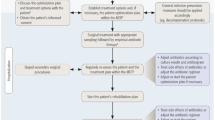Abstract
Between November 1984 and January 1994 in our department, a total of 2500 patients were treated with totally absorbable internal fixation devices. We studied these patients and analyzed results with regard to the volume of the absorbable implants and the development of wound infection. Of the 2500 patients 2044 were trauma patients and 456 were operated on for orthopedic disease. In 1466 patients treated with implants made of self-reinforced polyglycolic acid (SR-PGA) only, the patients who developed wound infection had a higher implant volume (P=0.07) than those who did not; this difference was close to statistical significance. In the 446 patients who received only implants made of self-reinforced poly-l-lactic acid (SR-PLLA), the 5 who developed wound infection had a mean implant volume more than three times that of the non-infected patients (P=0.01). We found that in the patients treated with the earlier SR-PGA implants, which contained a green staining material, there was no correlation between implant volume and incidence of wound infections. On the other hand, both the non-stained SR-PGA implants, which have been in clinical use since 1989, and the SR-PLLA implants, seem to be more predictable in terms of wound infections. We believe that this difference, is largely due to the lower level of tissue reactions with these newer implants.
Similar content being viewed by others
References
Böstman O, Partio EK, Hirvensalo E, et al. Foreign-body reactions to polyglycolide screws. Observations in 24/216 malleolar fracture cases. Acta Orthop Scand 1992;63(2):173–6.
Böstman O. Intense granulomatous inflammatory lesions associated with absorbable internal fixation devices made of polyglycolide in ankle fractures. Clin Orthop 1992;278:193–9.
Gristina AG. Biomaterial-centered infection: Microbial adhesion versus tissue integration. Science 1987;237:1588–95.
Hirvensalo E. Absorbable synthetic self-reinforced polymer rods in the fixation of fractures and osteotomies. Thesis, University of Helsinki, 1990:17–20.
Kobayashi H, Shiraki K, Ikada Y. Toxicity test of biodegradable polymers by implantation in rabbit cornea. J Biomed Mater Res 1992;26:1463–76.
Majola A, Vainionpää S, Vihtonen K, et al. Absorption, biocompatibility, and fixation properties of polylactic acid in bone tissue: An experimental study in rats. Clin Orthop 1991;268:260–9.
Matsusue Y, Hanafusa S, Yamamuro T, et al. Tissue reaction of bioabsorbable ultra high strength poly (L-lactide) rod. Clin Orthop 1995;317:246–53.
Partio EK. Absorbable screws in the fixation of cancellous bone fractures and arthrodeses. Thesis, University of Helsinki, 1992:17–21.
Pihlajamäki H, Böstman O, Manninen M, et al. Tissue-implant interface at an absorbable fracture fixation plug made of polylactide in cancellous bone of distal rabbit femur. Arch Orthop Trauma Surg 1994;113:101–5.
Rokkanen P, Böstman O, Vainionpää S, et al. Biodegradable implants in fracture fixation: Early results of treatment of the fractures of the ankle. Lancet 1985;1422–4.
Sinisaari I, Pätiälä H, Böstman O, et al. Wound infections associated with absorbable or metallic devices used in the fixation of fractures, arthrodeses and osteotomies. Eur J Orthop Surg Traumatol 1995;5:41–3.
Sinisaari I, Pätiälä H, Böstman O, et al. Metallic or absorbable implants for ankle fractures. A comparative study of infections in 3111 cases. Acta Orthop Scand 1996;67(1):16–8.
Author information
Authors and Affiliations
About this article
Cite this article
Sinisaari, I., Pätiälä, H., Böstman, O. et al. Effect of totally absorbable implant volume on wound infection rate: Study of 2500 operated fractures, osteotomies, and ligament injuries. J Orthop Sci 2, 88–92 (1997). https://doi.org/10.1007/BF02489518
Received:
Accepted:
Issue Date:
DOI: https://doi.org/10.1007/BF02489518




